Empire State Building
| Empire State Building | |
|---|---|
|
Seen from a Park Avenue skyscraper (August 2007) | |
| Record height | |
| Tallest in the world from 1931 to 1970[I] | |
| Preceded by | Chrysler Building |
| Surpassed by | World Trade Center (Twin Towers) |
| General information | |
| Type | Office building; observation deck |
| Architectural style | Art Deco |
| Location |
350 Fifth Avenue Manhattan, New York 10118[note 1] |
| Construction started | March 17, 1930[1] |
| Completed | April 11, 1931[2][3] |
| Opening | May 1, 1931; 85 years ago |
| Cost |
$40,948,900[4] ($638 million in 2016 dollars[5]) |
| Owner | Empire State Realty Trust |
| Height | |
| Architectural | 1,250 ft (381.0 m)[6][7] |
| Tip | 1,454 ft (443.2 m)[7] |
| Roof | 1,250 ft (381.0 m) |
| Top floor | 1,224 ft (373.1 m)[7] |
| Observatory | 1,224 ft (373.1 m)[7] |
| Dimensions | |
| Other dimensions |
length (east-west) 424 ft (129.2 m) width (north-south) 187 ft (57.0 m)[8] |
| Technical details | |
| Floor count | 102[7][8][9][note 2] |
| Floor area | 2,248,355 sq ft (208,879 m2)[7] |
| Lifts/elevators | 73[7] |
| Design and construction | |
| Architect | Shreve, Lamb and Harmon |
| Developer | John J. Raskob |
| Structural engineer | Homer Gage Balcom[10] |
| Main contractor | Starrett Brothers and Eken |
|
Empire State Building | |
   Location in New York City[11] | |
| Coordinates | 40°44′54.36″N 73°59′08.36″W / 40.7484333°N 73.9856556°WCoordinates: 40°44′54.36″N 73°59′08.36″W / 40.7484333°N 73.9856556°W |
| NRHP Reference # | 82001192 |
| Significant dates | |
| Added to NRHP | November 17, 1982 |
| Designated NHL | June 24, 1986 |
| Designated NYCL | May 19, 1981 |
| References | |
|
I. ^ Empire State Building at Emporis [7][12][13] | |
The Empire State Building is a 102-story[7][8][9][note 2] skyscraper located on Fifth Avenue between West 33rd and 34th Streets in Midtown, Manhattan, New York City. It has a roof height of 1,250 feet (381 m), and with its antenna spire included, it stands a total of 1,454 feet (443 m) high.[7] Its name is derived from the nickname for New York, the Empire State. It stood as the world's tallest building for nearly 40 years, from its completion in early 1931 until the topping out of the original World Trade Center's North Tower in late 1970.[14] Following the September 11 attacks in 2001, the Empire State Building was again the tallest building in New York, until One World Trade Center reached a greater height in April 2012.[15] The Empire State Building is currently the fifth-tallest completed skyscraper in the United States and the 29th-tallest in the world. It is also the fifth-tallest freestanding structure in the Americas. When measured by pinnacle height, it is the fourth-tallest building in the United States.
The Empire State Building is an American cultural icon. It is designed in the distinctive Art Deco style and has been named as one of the Seven Wonders of the Modern World by the American Society of Civil Engineers. The building and its street floor interior are designated landmarks of the New York City Landmarks Preservation Commission, and confirmed by the New York City Board of Estimate.[16] It was designated as a National Historic Landmark in 1986.[12][17][18] In 2007, it was ranked number one on the AIA's List of America's Favorite Architecture.
The building is owned by the Empire State Realty Trust, of which Anthony Malkin serves as Chairman, CEO and President.[19] In 2010, the Empire State Building underwent a $550 million renovation, with $120 million spent to transform the building into a more energy efficient and eco-friendly structure.[20] The Empire State Building is the tallest Leadership in Energy and Environmental Design (LEED)-certified building in the United States, having received a gold LEED rating in September 2011.[21]
History
The site of the Empire State Building was first developed as the John Thompson Farm in the late 18th century.[22] At the time, a stream ran across the site, emptying into Sunfish Pond, located a block away. Beginning in the late 19th century, the block was occupied by the Waldorf-Astoria Hotel,[23] frequented by The Four Hundred, the social elite of New York.
The limestone for the Empire State Building came from the Empire Mill in Sanders, Indiana which is an unincorporated town adjacent to Bloomington, Indiana. The Empire Mill Land office is near State Road 37 and Old State Road 37 just south of Bloomington. The Bloomington, Bedford, and Oolitic area is known locally as the limestone capital of the world.[24][25]
Design and construction

The Empire State Building was designed by William F. Lamb from the architectural firm Shreve, Lamb and Harmon, which produced the building drawings in just two weeks, using its earlier designs for the Reynolds Building in Winston-Salem, North Carolina, and the Carew Tower in Cincinnati, Ohio (designed by the architectural firm W. W. Ahlschlager & Associates) as a basis.[26][27] Every year the staff of the Empire State Building sends a Father's Day card to the staff at the Reynolds Building in Winston-Salem to pay homage to its role as predecessor to the Empire State Building.[28] The building was designed from the top down.[29] The general contractors were The Starrett Brothers and Eken, and the project was financed primarily by John J. Raskob and Pierre S. du Pont. The construction company was chaired by Alfred E. Smith, a former Governor of New York and James Farley's General Builders Supply Corporation supplied the building materials.[1] John W. Bowser was project construction superintendent.[30][31][32]
Excavation of the site began on January 22, 1930, and construction on the building itself started on March 17—St. Patrick's Day—per Al Smith's influence as Empire State, Inc. president. The project involved 3,400 workers, mostly immigrants from Europe, along with hundreds of Mohawk iron workers, many from the Kahnawake reserve near Montreal. According to official accounts, five workers died during the construction.[33] Governor Smith's grandchildren cut the ribbon on May 1, 1931. Lewis Wickes Hine's photography of the construction provides not only invaluable documentation of the construction, but also a glimpse into common day life of workers in that era.[34]
The construction was part of an intense competition in New York for the title of "world's tallest building". Two other projects fighting for the title, 40 Wall Street and the Chrysler Building, were still under construction when work began on the Empire State Building. Each held the title for less than a year, as the Empire State Building surpassed them upon its completion, on April 11, 1931, 12 days ahead of schedule, just 410 days after construction commenced.[2] The building was officially opened on May 1, 1931 in dramatic fashion, when United States President Herbert Hoover turned on the building's lights with the push of a button from Washington, D.C. Ironically, the first use of tower lights atop the Empire State Building, the following year, was for the purpose of signaling the victory of Franklin D. Roosevelt over Hoover in the presidential election of November 1932.[35]
Opening
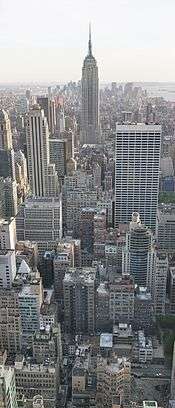
The building's opening coincided with the Great Depression in the United States, and as a result much of its office space was initially unrented. The building's vacancy was exacerbated by its poor location on 34th Street, which placed it relatively far from public transportation, as Grand Central Terminal and Penn Station, built decades beforehand, are several blocks away, as is the more recently built Port Authority Bus Terminal. Other more successful skyscrapers, such as the Chrysler Building, did not have this problem. In its first year of operation, the observation deck took in approximately 2 million dollars, as much money as its owners made in rent that year. The lack of renters led New Yorkers to deride the building as the "Empty State Building".[36][37] The building only became profitable in 1950. The 1951 sale of the Empire State Building to Roger L. Stevens and his business partners was brokered by the prominent upper Manhattan real-estate firm Charles F. Noyes & Company for a record $51 million. At the time, that was the highest price paid for a single structure in real-estate history.[38]
Incidents
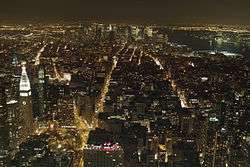
1945 plane crash
At 9:40 am on Saturday, July 28, 1945, a B-25 Mitchell bomber, piloted in thick fog by Lieutenant Colonel William Franklin Smith, Jr.,[39] crashed into the north side of the Empire State Building, between the 79th and 80th floors, where the offices of the National Catholic Welfare Council were located. One engine shot through the side opposite the impact and flew as far as the next block, where it landed on the roof of a nearby building, starting a fire that destroyed a penthouse. The other engine and part of the landing gear plummeted down an elevator shaft. The resulting fire was extinguished in 40 minutes. Fourteen people were killed in the incident.[40][41] Elevator operator Betty Lou Oliver survived a plunge of 75 stories inside an elevator, which still stands as the Guinness World Record for the longest survived elevator fall recorded.[42] Despite the damage and loss of life, the building was open for business on many floors on the following Monday. The crash helped spur the passage of the long-pending Federal Tort Claims Act of 1946, as well as the insertion of retroactive provisions into the law, allowing people to sue the government for the incident.[43]
A year later, another aircraft narrowly missed striking the building.[44]
Suicide attempts
Over the years, more than 30 people have attempted suicide, most successfully, by jumping from the upper parts of the building.[45] The first suicide occurred even before its completion, by a worker who had been laid off. The fence around the observatory terrace was put up in 1947 after five people tried to jump during a three-week span.[46]
On December 16, 1943, ex-United States Navy gunner's mate William Lloyd Rambo, 22, jumped to his death from the 86th floor, landing amidst Christmas shoppers on the street below.[47] In the early morning of September 27, 1946, shell-shocked 27-year-old Marine Douglas W. Brashear, Jr. jumped from the 76th-floor window of the Grant Advertising Agency after phoning a co-worker to tell her "I know now this is the end." Police found his shoes 50 feet from his body.[48]
On May 1, 1947, 23-year-old Evelyn McHale leapt to her death from the 86th floor observation deck and landed on a limousine parked at the curb. Photography student Robert Wiles took a photo of McHale's oddly intact corpse a few minutes after her death. The police found a suicide note among possessions she left on the observation deck: "He is much better off without me ... I wouldn’t make a good wife for anybody". The photo ran in the edition of May 12, 1947 of Life magazine,[49] and is often referred to as "The Most Beautiful Suicide". It was later used by visual artist Andy Warhol in one of his prints entitled Suicide (Fallen Body).[50]
Only one person has jumped from the upper observatory: on November 3, 1932, Frederick Eckert, of Astoria, ran past a guard in the enclosed 102nd floor gallery and jumped a gate leading to an outdoor catwalk intended for dirigible passengers. He landed and died on the roof of the 86th floor observation promenade.[51]
Two people have survived jumps, in both cases by not falling more than a floor: On December 2, 1979, Elvita Adams jumped from the 86th floor, only to be blown back onto a ledge on the 85th floor by a gust of wind and left with a broken hip.[52][53][54] On April 25, 2013, a man, who is presumed to have jumped, fell from the 86th floor observation deck but landed alive on an 85th floor ledge – where security guards brought him inside with minor injuries.[55]
Shootings
Two major shooting incidents have occurred at or in front of the Empire State Building.
On February 23, 1997, at about 5 p.m. EST, a gunman shot seven people on the 86th floor observation deck. Abu Kamal, a 69-year-old Palestinian teacher, killed one person and wounded six others, supposedly in response to events happening in Palestine and Israel, before committing suicide.[56]
On August 24, 2012 at about 9 a.m. EDT, on the sidewalk at the Fifth Avenue side of the building, a gunman shot and killed a former co-worker from a workplace that had laid him off in 2011. When two police officers confronted the gunman, 58-year-old Jeffrey T. Johnson, he aimed his firearm at them. They responded by firing 16 shots at Johnson, killing him but also wounding nine bystanders, most of whom were hit by fragments, although three took direct hits from bullets.[57]
Architecture

Interior
The Empire State Building rises to 1,250 ft (381 m) at the 102nd floor, and including the 203 ft (62 m) pinnacle, its full height reaches 1,453 feet 8 9⁄16 inches (443.092 m). The building has 85 stories of commercial and office space representing 2,158,000 sq ft (200,500 m2) of rentable space. It has an indoor and outdoor observation deck on the 86th floor. The remaining 16 stories represent the Art Deco tower, which is capped by a 102nd-floor observatory. Atop the tower is the 203 ft (62 m) pinnacle, much of which is covered by broadcast antennas, with a lightning rod at the very top.
The Empire State Building was the first building to have more than 100 floors. It has 6,500 windows and 73 elevators, and there are 1,860 steps from street level to the 102nd floor. It has a total floor area of 2,768,591 sq ft (257,211 m2); the base of the Empire State Building is about 2 acres (8,094 m2). The building houses 1,000 businesses and has its own ZIP code, 10118. As of 2007, approximately 21,000 employees work in the building each day, making the Empire State Building the second-largest single office complex in America, after the Pentagon. The building was completed in one year and 45 days. Its original 64 elevators are located in a central core;[58] today, the Empire State Building has 73 elevators in all, including service elevators. It takes less than one minute by elevator to get to the 80th floor, which contains a gift shop and an exhibit detailing the building's construction. From there, visitors can take another elevator or climb the stairs to the 86th floor, where an outdoor observation deck is located. The building has 70 mi (113 km) of pipe, 2,500,000 ft (760,000 m) of electrical wire,[59] and about 9,000 faucets. It is heated by low-pressure steam; despite its height, the building only requires between 2 and 3 psi (14 and 21 kPa) of steam pressure for heating. It weighs approximately 370,000 short tons (340,000 t). The exterior of the building is clad in Indiana limestone panels.
The Empire State Building cost $40,948,900 to build[4] (equivalent to $638,247,300 in 2016). Long-term forecasting of the life cycle of the structure was implemented at the design phase to ensure that the building's future intended uses were not restricted by the requirements of previous generations. This is particularly evident in the over-design of the building's electrical system.
The building's art deco design is typical of pre–World War II architecture in New York. The modernistic stainless steel canopies of the entrances on 33rd and 34th Streets lead to two story-high corridors around the elevator core, crossed by stainless steel and glass-enclosed bridges at the second-floor level. The elevator core contains 67 elevators.[16]
The lobby is three stories high and features an aluminum relief of the skyscraper without the antenna, which was not added to the spire until 1952. The north corridor contained eight illuminated panels, created by Roy Sparkia and Renée Nemorov in 1963 in time for the 1964 World's Fair, which depicts the building as the Eighth Wonder of the World, alongside the traditional seven. These panels were eventually moved near a ticketing line for the observation deck.
Until the 1960s, the ceilings in the lobby had a shiny art deco mural inspired by both the sky and the Machine Age, until it was covered with ceiling tiles and fluorescent lighting. Because the original murals, designed by an artist named Leif Neandross, were damaged, reproductions were installed. Over 50 artists and workers used 15,000 square feet of aluminum and 1,300 square feet of 23-carat gold leaf to re-create the mural. Renovations to the lobby alluded to original plans for the building; replacing the clock over the information desk in the Fifth Avenue lobby with an anemometer, as well as installing two chandeliers originally intended to be part of the building when it first opened.[60] In 2000, the building's owners installed a series of paintings by the New York artist Kysa Johnson in the concourse level. In January 2014 the artist filed suit in federal court in New York under the Visual Artists Rights Act, alleging the negligent destruction of the paintings and damage to her reputation as an artist.[61]
The building's lobbies and common areas received a $550 million renovation in 2009, which included new air conditioning, waterproofing, and renovating the observation deck; moving the gift shop to the 80th floor.[62] Of this, $120 million was spent in an effort to transform the building into a more energy efficient and eco-friendly structure.[20] For example, the 6,500 windows were remanufactured onsite into superwindows which block heat but pass light. Air conditioning operating costs on hot days were reduced and this saved $17 million of the project's capital cost immediately, partly funding other retrofitting.[63] Receiving a gold Leadership in Energy and Environmental Design (LEED) rating in September 2011, the Empire State Building is the tallest LEED certified building in the United States.[21]
Features
Above the 102nd floor
On the 102nd floor of the Empire State Building there is a door with stairs ascending to the 103rd floor.[64] This was built as a disembarkation floor for airships tethered to the building's spire, and has a circular balcony outside.[65] It is now a hot spot for celebrities, and an access point to reach the spire for maintenance. The room now contains electrical equipment. Above the 103rd floor, there is a set of stairs and a ladder to reach the spire for maintenance work.
The building's Art Deco spire was designed to be a mooring mast and depot for dirigibles.[66] An elevator between the 86th and 102nd floors would carry passengers after they checked in on the 86th floor.[67] The idea proved impractical and dangerous, due to the powerful updrafts caused by the building itself,[68] as well as the lack of mooring lines tying the other end of the craft to the ground.[69] The building's design was expanded to include the mooring mast as part of a competition for the world's tallest building.
A large broadcast tower was added atop the spire in the early 1950s, to support the transmission antennas of several television and FM stations. Until then, NBC had exclusive rights to the site, and – beginning in 1931 – built various, smaller antennas for their television transmissions.[66]
Broadcast stations
New York City is the largest media market in the United States. Since the September 11 attacks, nearly all of the city's commercial broadcast stations (both television and FM radio) have transmitted from the top of the Empire State Building, although a few FM stations are located at the nearby Condé Nast Building. Most New York City AM stations broadcast from sites across the Hudson River in New Jersey or from other surrounding areas.
Broadcasting began at the Empire State Building on December 22, 1931, when RCA began transmitting experimental television broadcasts from a small antenna erected atop the spire. They leased the 85th floor and built a laboratory there, and—in 1934—RCA was joined by Edwin Howard Armstrong in a cooperative venture to test his FM system from the building's antenna. When Armstrong and RCA fell out in 1935 and his FM equipment was removed, the 85th floor became the home of RCA's New York television operations, first as experimental station W2XBS channel 1, which eventually became (on July 1, 1941) commercial station WNBT, channel 1 (now WNBC-TV channel 4). NBC's FM station (WEAF-FM, now WQHT) began transmitting from the antenna in 1940. NBC retained exclusive use of the top of the building until 1950, when the FCC ordered the exclusive deal broken, based on consumer complaints that a common location was necessary for the (now) seven New York-area television stations (five licensed to New York City, NY, one licensed to Newark, NJ, and one licensed to Secaucus, NJ) to transmit from so that receiving antennas would not have to be constantly adjusted. Construction on a giant tower began. Other television broadcasters then joined RCA at the building, on the 83rd, 82nd, and 81st floors, frequently bringing sister FM stations along for the ride. Multiple transmissions of TV and FM began from the new tower in 1951. In 1965, a separate set of FM antennas was constructed ringing the 103rd floor observation area to act as a master antenna. When the World Trade Center was being constructed, it caused serious reception problems for the television stations, most of which then moved to the World Trade Center as soon as it was completed. This made it possible to renovate the antenna structure and the transmitter facilities for the benefit of the FM stations remaining there, which were soon joined by other FMs and UHF TVs moving in from elsewhere in the metropolitan area. The destruction of the World Trade Center necessitated a great deal of shuffling of antennas and transmitter rooms to accommodate the stations moving back uptown.
As of 2012, the Empire State Building is home to the following stations:
- Television broadcasting: WCBS-2, WNBC-4, WNYW-5, WABC-7, WWOR-9 Secaucus, WPIX-11, WNET-13 Newark, WNYE-25, WPXN-31, WXTV-41 Paterson, WNJU-47 Linden and WFUT-68 Newark
- FM broadcasting: WBMP-92.3, WPAT-93.1 Paterson, WNYC-93.9, WPLJ-95.5, WXNY-96.3, WQHT-97.1, WSKQ-97.9, WEPN-98.7, WBAI-99.5, WHTZ-100.3 Newark, WCBS-101.1, WFAN-101.9, WNEW-FM-102.7, WKTU-103.5 Lake Success, WAXQ-104.3, WWPR-105.1, WQXR-105.9 Newark, WLTW-106.7 and WBLS-107.5
Observation decks
The Empire State Building has one of the most popular outdoor observatories in the world, having been visited by over 110 million people. The 86th-floor observation deck offers impressive 360-degree views of the city. There is a second observation deck on the 102nd floor that is open to the public. It was closed in 1999, but reopened in November 2005. It is completely enclosed and much smaller than the first one; it may be closed on high-traffic days. Tourists may pay to visit the observation deck on the 86th floor and an additional amount for the 102nd floor.[70] The lines to enter the observation decks, according to Concierge.com, are "as legendary as the building itself:" there are five of them: the sidewalk line, the lobby elevator line, the ticket purchase line, the second elevator line, and the line to get off the elevator and onto the observation deck.[71] For an extra fee tourists can skip to the front of the line.[70] The Empire State Building makes more money from tickets sales for its observation decks than it does from renting office space.[72]
The skyscraper's observation deck plays host to several cinematic, television, and literary classics including, An Affair To Remember, On the Town, Love Affair and Sleepless in Seattle. In the Latin American literary classic, Giannina Braschi's Empire of Dreams the observation deck is the site of a pastoral revolution; shepherds take over the City of New York.[73] The deck was also the site of a publicity-stunt Martian invasion in an episode of I Love Lucy ("Lucy Is Envious", season 3, episode 25).

New York Skyride
The Empire State Building also has a motion simulator attraction located on the 2nd floor. Opened in 1994 as a complement to the observation deck, the New York Sky ride (or NY Sky ride) is a simulated aerial tour over the city. The cinematic presentation lasts approximately 25 minutes. As of May 2013, tickets are Adults $57, Children $42, Seniors $49.
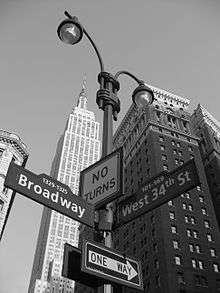
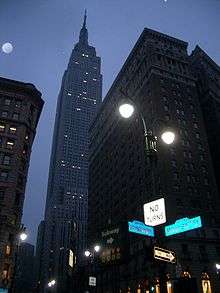
Since its opening, the ride has gone through two incarnations. The original version, which ran from 1994 until around 2002, featured James Doohan, Star Trek's Scotty, as the airplane's pilot, who humorously tried to keep the flight under control during a storm, with the tour taking an unexpected route through the subway, Coney Island, and FAO Schwartz, among other places. After the September 11 attacks in 2001, however, the ride was closed, and an updated version debuted in mid-2002 with actor Kevin Bacon as the pilot. The new version of the narration attempted to make the attraction more educational, and included some minor post-9/11 patriotic undertones with retrospective footage of the World Trade Center. The new flight also goes haywire, but this segment is much shorter than in the original.
Lights
In 1964, floodlights were added to illuminate the top of the building at night.[74] Since 1976 the spire has been lit in colors chosen to match seasonal and other events, such as St. Patrick's Day, Christmas, Independence Day and Bastille Day. After the eightieth birthday and subsequent death of Frank Sinatra, for example, the building was bathed in blue light to represent the singer's nickname "Ol' Blue Eyes". After the death of actress Fay Wray (King Kong) in late 2004, the building stood in complete darkness for 15 minutes.[75]
The floodlights bathed the building in red, white, and blue for several months after the destruction of the World Trade Center, then reverted to the standard schedule.[76] On June 4, 2002, the Empire State Building donned purple and gold (the royal colors of Elizabeth II), in thanks for the United Kingdom playing the Star Spangled Banner during the Changing of the Guard at Buckingham Palace on September 12, 2001 (a show of support after the September 11 attacks).[77] This would also be shown after the Westminster Dog Show. Traditionally, in addition to the standard schedule, the building will be lit in the colors of New York's sports teams on the nights they have home games (orange, blue and white for the New York Knicks, red, white and blue for the New York Rangers, and so on). The first weekend in June finds the building bathed in green light for the Belmont Stakes held in nearby Belmont Park. The building is illuminated in tennis-ball yellow during the US Open tennis tournament in late August and early September. It was twice lit in scarlet to support nearby Rutgers University: once for a football game against the University of Louisville on November 9, 2006, and again on April 3, 2007 when the women's basketball team played in the national championship game.[78] On January 13, 2012, the building was lit in red, orange, and yellow to honor the 60th anniversary of NBC's The Today Show making it the first time the building was illuminated to honor a television program. From June 1 to 3, 2012, the building was lit in blue and white, the colors of the Israeli flag, in honor of the 49th annual Celebrate Israel Parade.[79]
During 2012, the building's metal halide lamps and floodlights were replaced with LED fixtures, increasing the available colors from nine to over 16 million. The computer-controlled system allows the building to be illuminated in ways that were unable to be done previously with plastic gels. For instance, on November 6, 2012, CNN used the top of the Empire State Building as a scoreboard for the 2012 United States presidential election. When incumbent president Barack Obama had reached the 270 electoral votes necessary to win re-election, the lights turned blue. Had Republican challenger Mitt Romney won, the building would have been lit red.[80] Also, on November 26, 2012, the building had its first ever synchronized light show, using music from recording artist Alicia Keys.[81][82] Those wishing to hear the music could tune to certain radio stations in the New York area. A video of the performance was posted online the next day.[83] In 2013 the lights were changed to Financial Times pink.[84] In the run-up week to Super Bowl XLVIII held at MetLife Stadium on February 2, 2014, the building was lit in a contest sponsored by the National Football League's wireless partner, Verizon Wireless to determine both the winner and fan support for the two teams via their team colors in the game through the #WhosGonnaWin Twitter hashtag, either the "action green" and navy blue of the Seattle Seahawks or orange and blue of the Denver Broncos, along with a light show during the game's halftime.[85]
Height records and comparisons


The Empire State Building remained the tallest man-made structure in the world for 23 years before it was surpassed by the Griffin Television Tower Oklahoma (KWTV Mast) in 1954. It was also the tallest free-standing structure in the world for 36 years before it was surpassed by the Ostankino Tower in 1967.
The longest world record held by the Empire State Building was for the tallest skyscraper (to structural height), which it held for 42 years until it was surpassed by the North Tower of the World Trade Center in 1972. An early-1970s proposal to dismantle the spire and replace it with an additional 11 floors, which would have brought the building's height to 1,494 feet (455 m) and made it once again the world's tallest at the time, was considered but ultimately rejected.[86]
With the destruction of the World Trade Center in the September 11 attacks, the Empire State Building again became the tallest building in New York City, and the second-tallest building in the Americas, surpassed only by the Willis Tower in Chicago. It is currently the fifth-tallest, surpassed by the Willis Tower, the Trump International Hotel and Tower (Chicago), 432 Park Avenue and the new One World Trade Center. One World Trade Center surpassed the roof height of the Empire State Building on April 30, 2012, and became the tallest building in New York City—on the way toward becoming the tallest building in the Americas at a planned 1,776 feet (541 m).
The Empire State Building is currently the fifth-tallest completed skyscraper in the United States, after the One World Trade Center, 432 Park Avenue in New York City, the Willis Tower and Trump International Hotel and Tower, both in Chicago. It is also the 25th-tallest in the world, the tallest now is Burj Khalifa, located in Dubai. It is also the fifth-tallest freestanding structure in the Americas.
On clear days, the building can be seen from much of the New York Metropolitan Area, and as far away as New Haven, Connecticut and Morristown, New Jersey.
Neighboring Midtown Manhattan landmarks
The Empire State Building anchors an area of Midtown which features other major Manhattan landmarks as well, including Macy's Herald Square, Koreatown,[87] Penn Station, Madison Square Garden, and the Flower District.[88] Together, these sites contribute to a significant volume of commuter and tourist pedestrian traffic traversing the southern portion of Midtown Manhattan.
In popular culture
Film
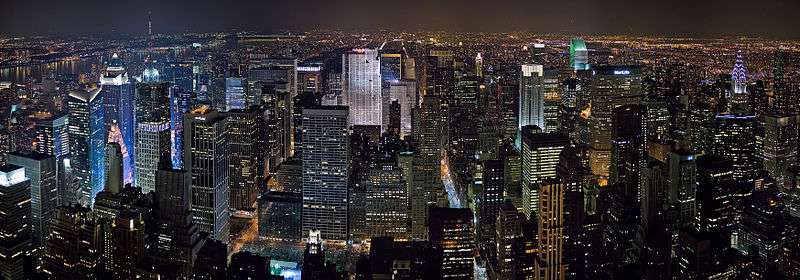
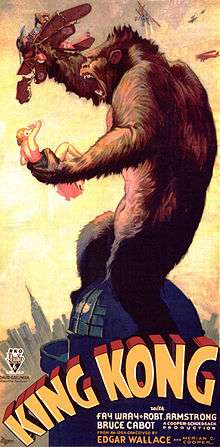
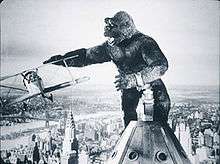
- Perhaps the most famous popular culture representation of the building is in King Kong (1933), in which the title character, a giant ape, climbs to the top to escape his captors but falls to his death after being attacked by airplanes. In 1983, for the film's fiftieth anniversary, a huge 90-foot (27 m) tall inflatable Kong was placed on the building mast above the observation deck by artist Robert Vicino.[89] In 2005, Peter Jackson's remake of King Kong was released, set in 1930s New York City, including a final showdown between Kong and biplanes atop a greatly detailed Empire State Building. (The 1976 remake of King Kong was set in a contemporary New York City and held its climactic scene on the towers of the World Trade Center.)
- Love Affair (1939) involves a couple who plan to meet atop the Empire State Building, a rendezvous that is prevented by an automobile accident. The film was remade in 1957 (as An Affair to Remember) and in 1994 (again as Love Affair). Sleepless in Seattle (1993), a romantic comedy partially inspired by An Affair to Remember, climaxes with scenes in the Empire State Building's lobby and observatory.
- In the Looney Tunes cartoon "Much Ado About Nutting", a squirrel has so much difficulty opening a coconut he carries it to the Empire State Building's observation deck and tosses it over the edge. While the street is damaged by the impact, the coconut remains intact.
- In the 1946 Looney Tunes cartoon Baseball Bugs, Bugs Bunny is pitching in the Polo Grounds against the Gashouse Gorillas. In the bottom of the ninth, with two outs and Bugs protecting a one run lead, the opposition hits the ball out of the park for an apparent game-winning two-run homer. Bugs pursues the ball through New York City. The chase culminates at the "Umpire State Building". Bugs ascends to the top of the building by elevator and catches the ball for the third out, winning the game.
- In the Tom and Jerry cartoon "Mouse in Manhattan", Jerry walks by and views the Empire State Building, along with other landmarks, including the Statue of Atlas at Rockefeller Center and Grand Central Terminal.
- Andy Warhol's 1964 silent film Empire is one continuous, eight-hour black-and-white shot of the Empire State Building at night. In 2004, the National Film Registry deemed its cultural significance worthy of preservation in the Library of Congress.
- In Percy Jackson & the Olympians: The Lightning Thief (2010), Mount Olympus is located over the Empire State Building, and there is a special elevator in the building to the "600th floor", which is supposed to be Olympus, just like in the book series.
- The building is chosen as Ground Zero for the target of a nuclear bomb that is dropped on New York in Fail-Safe (1964).
- Both Zero Mostel and Gene Wilder go to the Observation Deck of the building in the original Mel Brooks film The Producers.
- In The Time Machine (2002), the Empire State Building is still standing in the year 2030, but dwarfed by several larger skyscrapers around it. It is not visible in later scenes set in a post-apocalyptic New York.
- In Sky Captain and the World of Tomorrow (2004), the top of the building serves its original purpose of being a docking station for dirigibles, and the Hindenburg III docks at it on its maiden voyage.
- The building starred in Enchanted (2007) which Giselle tried to rescue Robert from Queen Narissa in her dragon form.
- Many films have opened with the Empire State Building, such as West Side Story (1961), Step Up 3D and The Other Guys (both 2010).
- The building has been destroyed in some disaster films, such as Independence Day (1996) and Knowing (2009).
- In The Divide (2011), the building is destroyed by a nuclear bomb detonated on New York. It was heavily featured on posters promoting the film.
- In Superman II (1980), Ursa (Sarah Douglas) uses a flagpole to knock Superman (Christopher Reeve) into the tower of the Chrysler Building. He ducks with Non (Jack O'Halloran) taking the blast. However, scenes showing the tower falling and being flown back to the top by Superman are of the Empire State Building.
- In The 5th Wave, the building happens to survive a massive tsunami that hits Manhattan during an alien invasion.
- Many other films that feature the Empire State Building are listed on the building's own website.[90]
Television
- In the 1965 four-part Underdog cartoon serial "The Phoney Booths" (episodes 49-52), Underdog falls under the mental control of mad scientist Simon Bar Sinister. Simon orders Underdog to use his super powers to bring him valuable objects - including the Empire State Building, which Underdog lifts whole to bring it to Simon. In the end, circumstances release Underdog from Simon’s control. He defeats the evil scientist and puts back the Empire State Building.
- The Empire State Building featured in the 1966 Doctor Who serial The Chase, in which the TARDIS lands on the roof of the building; The Doctor and his companions leave quite quickly, however, because The Daleks are close behind them. A Dalek is also seen on the roof of the building while it interrogates a human. In 2007, Doctor Who episodes "Daleks in Manhattan" and "Evolution of the Daleks" also featured the building, which the Daleks are constructing to use as a lightning conductor. Russell T Davies said in an article that "in his mind", the Daleks remembered the building from their last visit.
- In the science fiction drama series Fringe, the observation deck of the Empire State Building serves its primary purpose as a docking station for zeppelins in the parallel universe shown in the second-season episode Peter.
- The Discovery Channel show MythBusters tested the urban myth which claims that if one drops a penny off the top of the Empire State Building, it could kill someone or put a crater in the pavement. The outcome was that, by the time the penny hits the ground, it is going roughly 65 mph (105 km/h) (terminal velocity for an object of its mass and shape), which is not fast enough to inflict lethal injury or put a crater into the pavement. The urban legend is a joke in the 2003 musical Avenue Q, where a character waiting atop the building for a rendezvous tosses a penny over the side—only to hit her rival.
- In Gerry Anderson's popular puppet series Thunderbirds, the episode Terror in New York City, the Empire State Building is being moved to a new location as the site around it is set for redevelopment. However, something goes wrong and the building collapses, trapping a reporter and his cameraman underneath the rubble. Their rescue is the focus of the rest of the episode.
- The music video of the song "Everything is Everything" (by singer Lauryn Hill) prominently features the Empire State Building as the center of a city (record) turntable.
- In the episode "First Time in New York" of the television series How I Met Your Mother (originally aired on January 8, 2007), the gang takes Robin's sister Katie to the Empire State Building. On the first day, they only got to the lobby, but they eventually went to the top the next day.
Literature
- H.G. Wells' 1933 science fiction novel The Shape of Things to Come, written in the form of a history book published in the far future, includes the following passage: "Up to quite recently Lower New York has been the most old-fashioned city in the world, unique in its gloomy antiquity. The last of the ancient skyscrapers, the Empire State Building, is even now under demolition in C.E. 2106!".[91]
- David Macaulay's 1980 illustrated book Unbuilding depicts the Empire State Building being purchased by a Middle Eastern billionaire and disassembled piece by piece, to be transported to Saudi Arabia and rebuilt there. The mooring mast is rebuilt in New York, while the remainder of the building is lost at sea.
- Giannina Braschi's Empire of Dreams, a Latin American poetry epic published in 1988, featured a pastoral revolution on the top floor of the Empire State Building, where shepherds danced and sang songs of revolution.[73][92]
- The Empire State Building is featured prominently as both a setting and integral plot device throughout much of Michael Chabon's 2000 Pulitzer Prize-winning novel, The Amazing Adventures of Kavalier & Clay.
- In his "biography", Doc Savage: His Apocalyptic Life, Philip Jose Farmer theorizes that the skyscraper in which Doc Savage lived and where he met with his comrades, had his laboratories, etc., was the Empire State Building. Since the 86th Floor (mentioned in the Savage stories as his floor) was the Observatory, one may presume that Doc "actually" lived on another floor.
- In the series, "Percy Jackson & the Olympians", Rick Riordan shows the Empire State Building as the headquarters of the Olympian Gods, where the Greek Gods live and also hold their meetings.
- In the 1961 children's novel James and the Giant Peach by Roald Dahl, the giant peach is dropped onto the lightning rod of the Empire State Building at the end. This novel was later adapted in a film under the same name in 1996, which features the same part where the peach falls on to the Building's antenna.
- In the sci-fi/alternate history series of novels Wild Cards, the 86th floor is the location of New York's premier chic restaurant, Aces High, a very popular hangout for the superpowered aces.
Other
- A 7.6 feet (2.3 m) scale model built from 12,000 LEGO bricks over 250 hours is featured along with other notable buildings in the LEGO Architecture: Towering Ambition exhibition at the National Building Museum in Washington, D.C.[93]
- The Empire State Building Run-Up is a foot race from ground level to the 86th-floor observation deck that has been held annually since 1978. Its participants are referred to both as runners and as climbers, and are often tower running enthusiasts. The race covers a vertical distance of 1,050 feet (320 m) and takes in 1,576 steps. The record time is 9 minutes and 33 seconds, achieved by Australian professional cyclist Paul Crake in 2003,[94][95] at a climbing rate of 6,593 ft (2,010 m) per hour.
Notable tenants
|
Current
|
Former
|
Gallery
 Sunrise (December 2005)
Sunrise (December 2005)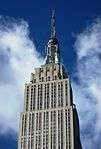 Spire seen from east on 34th Street (2013)
Spire seen from east on 34th Street (2013)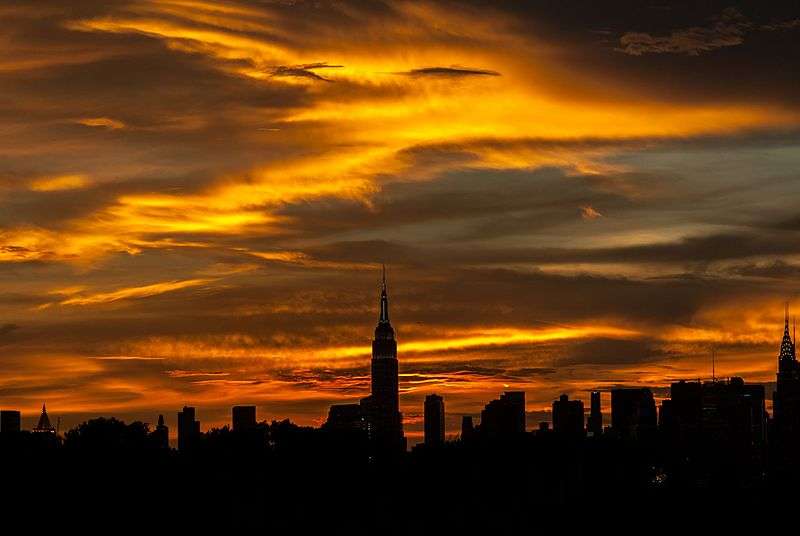 As seen from Queens during sunset (August 2016)
As seen from Queens during sunset (August 2016)- As seen from Washington Square Park
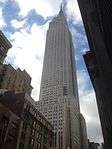 As seen from ground level on 35th Street
As seen from ground level on 35th Street- As seen from Broadway and 21st Street
 As seen from the distance at sunset
As seen from the distance at sunset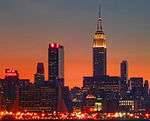 View from Weehawken, New Jersey
View from Weehawken, New Jersey- Street-level side view, 2013
- Griffin sculptures over front entrance, 2013
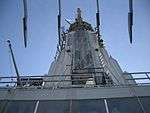 Looking up from the observation deck
Looking up from the observation deck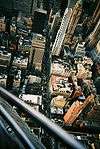 Looking down
Looking down- Looking toward Times Square
 lit in Purple for the National Purple Heart day
lit in Purple for the National Purple Heart day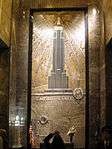 Mural of the building, located in the lobby
Mural of the building, located in the lobby- Art deco elevators in the lobby
- Building souvenir
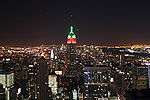 Lit in red and green lights for Christmas, as seen from the GE Building
Lit in red and green lights for Christmas, as seen from the GE Building- With Christmas lights
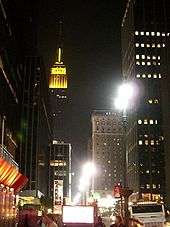 Lit in yellow to promote The Simpsons Movie home video release
Lit in yellow to promote The Simpsons Movie home video release Lit in yellow and red during the 60th anniversary of the PRC
Lit in yellow and red during the 60th anniversary of the PRC- Lit in blue after Barack Obama was declared winner of the 2012 United States Presidential Election (in the US, red commonly represents Republicans, blue for Democrats)
See also
- List of buildings with 100 floors or more
- List of tallest buildings in the world
- List of tallest buildings in the United States
- List of tallest buildings in New York City
- List of tallest buildings by U.S. state
- List of tallest freestanding structures in the world
- History of the tallest skyscrapers
References
Notes
- ↑ The Empire State Building is located within the 10001 zip code area, but 10118 is assigned as the building's own zip code, according to the United States Postal Service.
- 1 2 Depending on the source, the floor count of the Empire State Building is variously cited as 102 or 103. The sources cited here all state 102. See here for a detailed explanation.
Citations
- 1 2 Willis, Carol (1995). "Empire State Building". In Kenneth T. Jackson. The Encyclopedia of New York City. New Haven, CT & London & New York: Yale University Press & The New-York Historical Society. pp. 375–376.
- 1 2 "Historic Construction Projects". generalcontractor.com. Retrieved 11 May 2015.
- ↑ "Made How: Skyscraper". madehow.com. Retrieved 11 May 2015.
- 1 2 Rosenberg, Jennifer. "Empire State Building Trivia and Cool Facts". About.com. Retrieved November 8, 2008.
- ↑ Federal Reserve Bank of Minneapolis Community Development Project. "Consumer Price Index (estimate) 1800–". Federal Reserve Bank of Minneapolis. Retrieved October 21, 2016.
- ↑ "Visit NYC Observatory - NYC Tourism - Empire State Building". Empire State Building.
- 1 2 3 4 5 6 7 8 9 10 "Empire State Building" The Skyscraper Center Council on Tall Buildings and Urban Habitat website
- 1 2 3 Emporis GmbH. "Empire State Building, New York City - 114095 - EMPORIS". emporis.com.
- 1 2 "Empire State Building" SkyscraperPage
- ↑ "Homer G. Balcom, Engineer, Is Dead". The New York Times. July 5, 1938. Retrieved August 8, 2011.
- ↑ National Geodetic Survey datasheet KU3602. Retrieved July 26, 2009.
- 1 2 "Empire State Building". National Historic Landmark summary listing. National Park Service. September 11, 2007. Archived from the original on August 28, 2011.
- ↑ National Park Service (2007-01-23). "National Register Information System". National Register of Historic Places. National Park Service.
- ↑ History of the Twin Towers, archived from the original on December 28, 2013, retrieved January 26, 2014
- ↑ "It's official: 1 WTC is New York's new tallest building". NY Daily News. April 30, 2012. Retrieved April 30, 2012.
- 1 2 White, Norval & Willensky, Elliot (2000), AIA Guide to New York City (4th ed.), New York: Three Rivers Press, ISBN 978-0-8129-3107-5 p.226.
- ↑ Pitts, Carolyn (April 26, 1985). "Empire State Building" (PDF). National Historic Landmark Nomination. National Park Service.
- ↑ "Empire State Building—Accompanying 7 photos, exterior and interior, from 1978" (PDF). National Register of Historic Places Inventory. National Park Service. April 26, 1985.
- ↑ "Empire State Realty Trust". Retrieved March 7, 2014.
- 1 2 "2009 ULI Fall Meeting & Urban Land Expo — Green Retrofit: What Is Making This the Wave of the Future?" (PDF). Retrieved October 11, 2010.
- 1 2 "Empire State Building Achieves LEED Gold Certification | Inhabitat New York City". Inhabitat.com. Retrieved October 12, 2011.
- ↑ "Empire State Building : Official Internet Site". Esbnyc.com. Retrieved December 8, 2011.
- ↑ "History of The Empire State Building".
- ↑ Peterson, Iver (10 November 1981). "LIMESTONE CENTER TURNS TO TOURISM". The New York Times. Archived from the original on May 24, 2015. Retrieved 5 September 2016.
- ↑ "Cursed Pyramid Ruins". RoadsideAmerica.com. Archived from the original on July 22, 2016. Retrieved 5 September 2016.
- ↑ Reynolds Building. Retrieved November 15, 2008.
- ↑ "Cincinnati Skyscrapers, Waymarketing.com". Waymarking.com. Retrieved October 11, 2010.
- ↑ Covington, Owen (January 4, 2012), "A look at the historic Reynolds Building", The Business Journal, retrieved June 22, 2012
- ↑ Wagner, Geraldine B. (2003). Thirteen Months to Go: The Creation of the Empire State Building. San Diego: Thunder Bay Press. p. 12. ISBN 978-1-59223-105-8.
- ↑ "New York". The Travelling Historian. Retrieved October 11, 2010.
- ↑ "FINAL CURRICULUM" (PDF). Archived from the original (PDF) on July 16, 2011. Retrieved October 11, 2010.
- ↑
- ↑ about.com – Empire State Building Trivia and Cool Facts
- ↑ "Lewis Wickes Hine: The Construction of the Empire State Building, 1930–31 (New York Public Library Photography Collection)". Catalog.nypl.org. Archived from the original on February 21, 2009. Retrieved October 11, 2010.
- ↑ "Tower Lights History". Empire State Building. Retrieved December 16, 2007.
- ↑ "NYT Travel: Empire State Building". The New York Times. Retrieved October 11, 2010.
- ↑ Smith, Adam (August 18, 2008). "A Renters' Market in London". Time. Retrieved July 10, 2010.
- ↑ —New York: A Documentary Film.
- ↑ "750th Squadron 457th Bombardment Group: Officers – 1943 to 1945". Retrieved April 6, 2009.
- ↑ "Empire State Building Withstood Airplane Impact". Tms.org. Retrieved October 11, 2010.
- ↑ "Plane Hits Building – Woman Survives 75-Story Fall". Elevator-world.com. Archived from the original on July 10, 2011. Retrieved October 11, 2010.
- ↑ "ACTUAL ARTICLE TITLE BELONGS HERE!". guinnessworldrecords.com. Archived from the original on March 17, 2006. Retrieved October 11, 2010.
- ↑ "The Day A Bomber Hit The Empire State Building". NPR. Retrieved July 28, 2008.
Eight months after the crash, the U.S. government offered money to families of the victims. Some accepted, but others initiated a lawsuit that resulted in landmark legislation. The Federal Tort Claims Act of 1946, for the first time, gave American citizens the right to sue the federal government.
- ↑ Glanz, James; Lipton, Eric (September 8, 2002). "The Height of Ambition". The New York Times.
- ↑ "An urban icon where they used to go fishing". iht.com. Archived from the original on February 12, 2009.
- ↑ Reavill, Gil; Zimmerman, Jean (2003). Manhattan. Compass American Guides (4th ed.). New York: Compass American Guides. p. 160. ISBN 978-0-676-90495-6.
- ↑ "Youth Dives from Empire State Bldg.", from The Schenectady Gazette
- ↑ "Leaps to Death from 76th Floor", from The Tuscaloosa News
- ↑ "Picture of the Week". Life: 42–43. May 12, 1947. ISSN 0024-3019. Retrieved October 11, 2010.
- ↑ Dillenberger, Jane D. (February 1, 2001). The Religious Art of Andy Warhol. A&C Black. p. 67. ISBN 978-0-8264-1334-5.
- ↑ "Leaps to His Death Off Empire Tower". The New York Times. November 4, 1932. Retrieved October 4, 2011.
- ↑ Douglas, George H. (2004). Skyscrapers: A Social History of the Very Tall Building in America. London: McFarland. p. 173. ISBN 978-0-7864-2030-8. Retrieved October 11, 2010.
- ↑ Broughton, Geoffrey (1987). Expressions. London: Collins ELT. p. 32. ISBN 0-00-370641-9.
- ↑ Goldman 1980, p.63.
- ↑ Joseph Stepansky , Joe Kemp , Bryan Calcano AND Daniel Beekman / NEW YORK DAILY NEWS (April 25, 2013). "SKY FALL! Man tumbles off Empire State Building". Retrieved April 25, 2013.
- ↑ "Gunman shoots 7, kills self at Empire State Building". CNN. February 24, 1997. Archived from the original on April 20, 2010. Retrieved January 4, 2015.
- ↑ "Police: All Empire State shooting victims were wounded by officers". CNN. August 24, 2012. Retrieved January 4, 2015.
- ↑ Bonnier Corporation (April 1931). Popular Science. Bonnier Corporation. p. 44.
- ↑ "Facts & Trivia". Empire State Building. Retrieved July 10, 2010.
- ↑ Barron, James (September 22, 2009). "Overhead, a Lobby Is Restored to Old Glory". The New York Times. Archived from the original on March 6, 2014. Retrieved September 10, 2011.
- ↑ "Artist Files Suit Over Missing Empire State Building Paintings". New York Times. January 31, 2014. Retrieved February 1, 2014.
- ↑ "Empire State ReBuilding Transforms World's Most Famous Office Building" (Press release). Empire State Building. September 23, 2009. Archived from the original on May 9, 2012. Retrieved September 10, 2011.
- ↑ Amory Lovins (March–April 2012). "A Farewell to Fossil Fuels". Foreign Affairs.
- ↑ William Branigin (August 24, 2012). "Gunman shoots former co-worker near Empire State Building, is shot by police". Washington Post. Retrieved October 30, 2013.
The 103-floor Empire State Building draws
- ↑ Edward Rothstein (July 15, 2011). "A View Inside King Kong's Perch". The Times. The New York Times Company. Retrieved May 27, 2013.
The walkway circles around the building’s narrow spire, which, in 1930, was envisioned as a mooring mast for dirigibles.
- 1 2 Shanor, Rebecca Read (1995). "Unbuilt projects". In Kenneth T. Jackson. The Encyclopedia of New York City. Yale University Press & The New-York Historical Society. pp. 1208–1209.
- ↑ Hearst Magazines (May 1931). Popular Mechanics. Hearst Magazines. p. 812.
- ↑ Goldman 1980, p.44.
- ↑ "Intercity Dirigible Service". February 26, 2010. Retrieved October 1, 2010.
- 1 2 "ESB Tickets". Empire State Building. Retrieved July 10, 2010.
- ↑ "Ten Things Not to Do in New York". Concierge.com. Retrieved October 23, 2010.
- ↑ David Robertson (April 23, 2012). "No threat from large gorillas". The Times. Retrieved April 21, 2012.
According to details prepared for the proposed initial public offering of Empire State Realty Trust, the skyscraper earned $62.9 million from its observation deck in nine months last year, compared with $62.6 million from the rental of office space.
- 1 2 Marting, Diane (2010), New/Nueva York in Giannina Braschi's 'Poetic Egg': Fragile Identity, Postmodernism, and Globalization, Indiana: The Global South, pp. 167–182.
- ↑ Lelyveld, Joseph (February 23, 1964). "The Empire State to Glow at Night". The New York Times. Retrieved July 10, 2010.
- ↑ Tallmer, Jerry (September 29, 2004). "Whatever Happened to Fay Wray?". The Villager. Retrieved July 10, 2010.
- ↑ "Lighting Schedule". Empire State Building. Retrieved July 10, 2010.
- ↑ "The Tallest Buildings in the World". The Washington Post. January 4, 2010. Retrieved July 10, 2010.
- ↑ Schlabach, Mark (November 10, 2006). "Rutgers finds new level of success with win". ESPN. Retrieved July 10, 2010.
- ↑ Benhorin, Yitzhak (June 3, 2012). "NYC celebrates Israel with annual parade". Ynetnews. Retrieved November 27, 2012.
- ↑ Wells, Charlie (November 6, 2012). "Empire State Building lights up to broadcast election results". Daily News. New York. Retrieved November 27, 2012.
- ↑ "Empire State Building Light Show: LED Display Synchronized To Two Alicia Keys Songs Over Manhattan". Huffington Post. November 27, 2012. Retrieved November 27, 2012.
- ↑ "Philips Color Kinetics & Empire State Building Partnership". Philips Color Kinetics. Retrieved November 27, 2012.
- ↑ "Alicia Keys lights up the Empire State Building". iHeartRadio. Retrieved November 27, 2012.
- ↑ Empire State Building lit in FT pink | Flickr - Photo Sharing!. Flickr (May 1, 2013). Retrieved on 2014-06-23.
- ↑ Super Bowl Week - NFL Mobile. Verizonwireless.com. Retrieved on June 23, 2014.
- ↑ Carmody, Deirdre (October 11, 1972). "11 Floors May Be Added to the Empire State". The New York Times.
- ↑ Baldwin, Deborah (October 17, 2008). "Living In Koreatown Exotic Flavor, Beyond Just the Food". The New York Times. Retrieved September 25, 2011.
- ↑ "The Jungles of West 28th Street – Exploring New York's Flower District". Scouting NY. August 22, 2011. Retrieved October 5, 2012.
- ↑ De Moraes, Lisa (June 5, 2012). "Spike TV's 'Last Family on Earth': Coming to a bunker near you". Washington Post. Retrieved January 13, 2013.
the bunker space is being provided by the doomsday-shelter-building outfit Vivos, which is headed by Del Mar, Calif., developer Robert Vicino. He's the same guy who, way back in '83, installed an inflatable 10-story King Kong on the Empire State Building, to celebrate the original "King Kong" flick’s 50th anniversary.
- ↑ "ESB in the Movies". Empire State Building. Archived from the original on May 31, 2012. Retrieved October 19, 2011.
- ↑ "The Shape Of Things To Come". Gutenberg.net.au. Archived from the original on June 10, 2010. Retrieved October 23, 2010.
- ↑ "Modern Language Association Presents Giannina Braschi". Circumference Magazine: Poetry in Translation, Academy of American Poets. January 1, 2013.
’Considered one of the most revolutionary Latin American poets writing today, Giannina Braschi, author of the epic prose poem Empire of Dreams’
- ↑ "National Building Museum. LEGO Architecture: Towering Ambition". Nbm.org. Retrieved October 23, 2010.
- ↑ "NYRR Empire State Building Run-Up Crowns Dold and Walsham as Champions". New York Road Runners. February 6, 2007. Archived from the original on July 16, 2011. Retrieved July 10, 2010.
- ↑ "Past Race Winners". Empire State Building. Archived from the original on January 2, 2010. Retrieved July 10, 2010.
- ↑ "The Americas." Air China. Retrieved on October 15, 2012. "New York AIR CHINA Ltd.(New York) Empire State Building 350 Fifth Avenue, Suite 6905 New York, NY 10118"
- ↑ Charity Navigator Rating – Boy Scouts of America, Greater New York Councils.
- ↑ Coty expands in Empire State Building.
- 1 2 3 4 5 6 "Foreigners flocking to 350 Fifth Avenue." Real Estate Weekly. June 30, 2004.
- ↑ Home page. Croatian National Tourist Board. Retrieved September 4, 2008.
- ↑ FDIC to Move Into Empire State Building.
- ↑ "Contact." Filipino Reporter. Retrieved September 4, 2008.
- ↑ Human Rights Foundation.
- ↑ "Contact." Human Rights Watch. Retrieved September 4, 2008.
- ↑ Kaplan International school at ESB.
- ↑ Empire expansion.
- ↑ David M. Levitt. "The Tangled Tale Behind the Empire State Building's IPO". Businessweek.com.
- ↑ Pharma Firm Bolts Chrysler Building for Empire State.
- ↑ Reds Go Green: Chinese Communist Party Newspaper Signs Empire State Building Lease.
- ↑ Home Page. Polish Cultural Institute in New York. Retrieved September 4, 2008.
- ↑ "Contact Us - Qatar Airways Global".
- ↑ Four Tenants Claim Pre-Built Green Suites in Empire State Building.
- ↑ World Monuments Fund.
- ↑ "."
- ↑ "Contact Us." China National Tourist Office. Retrieved September 4, 2008.
- ↑ "Contact us." National Film Board of Canada. Retrieved September 4, 2008.
- ↑ In Answer to Ayn Rand by Nathaniel Branden at his ex-wife's website
Bibliography
- Aaseng, Nathan (1998). Construction: Building the Impossible. Minneapolis, MN: The Oliver Press, Inc. ISBN 978-1-881508-59-5.
- Bascomb, Neal (2003). Higher: A Historic Race to the Sky and the Making of a City. New York: Doubleday. ISBN 978-0-385-50660-1.
- Goldman, Jonathan (1980). The Empire State Building Book. New York: St. Martin's Press. ISBN 978-0-312-24455-2.
- James, Theodore, Jr. (1975). The Empire State Building. New York: Harper & Row. ISBN 978-0-06-012172-3.
- Kingwell, Mark (2006). Nearest Thing to Heaven: The Empire State Building and American Dreams. New Haven, CT: Yale University Press. ISBN 978-0-300-10622-0.
- Pacelle, Mitchell (2001). Empire: A Tale of Obsession, Betrayal, and the Battle for an American Icon. New York: Wiley. ISBN 978-0-471-40394-4.
- Tauranac, John (1995). The Empire State Building: The Making of a Landmark. New York: Scribner. ISBN 978-0-684-19678-7.
- Wagner, Geraldine B. (2003). Thirteen Months to Go: The Creation of the Empire State Building. San Diego, CA: Thunder Bay Press. ISBN 978-1-59223-105-8.
- Willis, Carol; Friedman, Donald (1998). Building the Empire State. New York: W.W. Norton. ISBN 978-0-393-73030-2.
External links
| Wikimedia Commons has media related to Empire State Building. |
| Look up Empire State Building in Wiktionary, the free dictionary. |
- Official website
- Empire State Building on CTBUH Skyscraper Center
- Empire State Building (1930) – film footage of the building's construction at British Pathé News
- Hearst Magazines (December 1930). Popular Mechanics. Hearst Magazines. p. 920.
- Empire State Building green retrofit archive at the Internet Archive
- Empire State Building trivia at About.com
- Empire State Building under construction (1930–1931) at the New York Public Library
- Empire State Building at Viva 2 – archive of over 500 construction photographs at The Skyscraper Museum
- Streetscapes: The Empire State Building slideshow at The New York Times
- List of tenants at the Empire State Building - Companies located at 350 5th Avenue, New York NY
| Records | ||
|---|---|---|
| Preceded by Chrysler Building |
World's tallest structure 1931–1954 |
Succeeded by KWTV Mast |
| World's tallest freestanding structure on land 1931–1967 |
Succeeded by Ostankino Tower | |
| Tallest building in the world 1931–1972 |
Succeeded by World Trade Center (1973–2001) | |
| Tallest building in the United States 1931–1972 | ||
| Tallest building in New York City 1931–1972 | ||
| Preceded by World Trade Center (1973–2001) |
Tallest building in New York City 2001–2013 |
Succeeded by One World Trade Center (current) |
